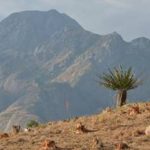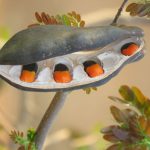TREE LIFE
September 2021
Covid-19 is still with us. However, we do have articles from Ian, Mark, Ryan and Ann, thanks. My plea for help in the last month’s issue was not in vain! We are delighted to welcome Rob Jarvis, whose expertise is well known with The Aloe, Cactus and Succulent Society and who has been a member of the Tree Society for many years. I can here soft mumblings from the Aloe, Cactus and Succulent Society, we are not taking Rob away from you, he is just adding another bow to his string. Thank you for your generous offer.
Msasa time by Rupert W. Jack
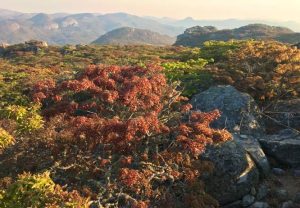
Photo: Marco Faccia
The love of trees lies ages deep
within the heart of man.
They’ve served his needs
They’ve stirred his soul, Since
human life began.
Ye dwellers of the Northern isles,
Mid oak and beech and pine,
Hold fast the love of your native woods
But leave me hold to mine.
I’ve built my home ‘neath
Southern Skies,
Where stretch on every hand,
The wide-flung open forests
Of our fair Mashonaland.
The cooling winds of autumn
Paint your woodlands bright and gay,
But the pigment of their leafage
Is the symbol of decay.
Here we show a brighter picture –
When the sap is rising free,
And the glory of the springtime
Crowns our gay msasa trees.
She asks no soft or humid airs
To tempt her leaflets forth,
The break to blazing
Unknown within the tempered North,
Whilst the grass is parched
And withered, whilst to soil’s
A thirst for rain,
The deep rooted Msasa wakes to
Pregnant life again.
Now see the forest canopy –
It’s wondrous hues unfold,
From deep maroon to crimson chestnut
And fawn and gold.
There’s never a tint a leaf has worn
But finds its fellow there,
When the brave Msasa burst their buds
in the arid August air,
O’er plain and slope and hilltop,
The varied mantles spread
The yellow grass beneath them,
The clear blue overhead.
The gradient glory of the scene
Transcends the poet’s art,
This beauty inexpressible
That clutches at the heart.
Rupert Jack wrote this poem about Msasa trees in springtime. Rupert was the Chief Entomologist of Southern Rhodesia from early 1900’s.
Tree Tobacco at Zimphos
In my article on Rumex at Zimphos and Epworth in Tree Life 488, I mentioned the base of the ‘purple hill’ as a site for a few Rumex bushes (incidentally, I have since found a few on the top of the hill, above those at the base). There is an error in this article, and the paragraph starting ‘Polygonaceae is also characterised…’ should read ‘Polygonaceae is also characterised by the stipules, which are thin and sheath the somewhat swollen stem nodes – called ochrea or ocrea, plural ochreæ.
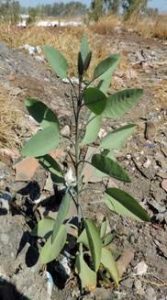
New plant. Photo: Ian Riddell
But getting back to climbing that hill. Actually, it is a dump, in more ways than one. But the artist who painted the hill had a palette blended with all shades of greys – tinged with dark reds, tinged with blues; a vermillion splash is smeared to the right of a cruel slash in the hill’s flank, exposing a glaring band of bone, white dabbed with oozes of sulphur yellow blood, and the road below bleeds into a dark purple – eggplant tinted with wine.
I negotiate my mountain bike along the track that spirals up and around the hill to the top, bumping around or over rivulets of erosion. At the top I’m rewarded with views; to the west the etched skyline of the city centre, to the north the cement factory squats on the horizon beyond Tafara, to the east patches of veld grasses in dry season yellows, dotted with grey granite boulders, and to the south the blinding white polygon of one of the dumps.
The icing on the top of this cake is rank and rotten, a layer of garbage typical of Harare roadsides these days! You don’t want to look at it any more than is needed to negotiate a path through or around it. But emerging from this murk, and the common shrub on the hilltop, were quite a few Tree Tobacco Nicotiana glauca. One largely recumbent specimen with a fissured stem diameter of c.25 cm had obviously been there a relatively long time. The glaucous, ovate leaves of new plants arose on long, grey-purple petioles with healthy vigour. Most attractive were the flowers with long, narrow, yellow corollas. Fresh fruits wear a crown of what I presume is the old anthers, older ones have dried and split.
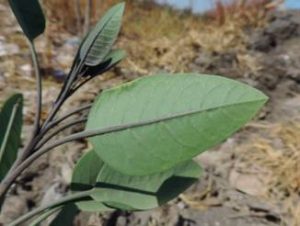
Underside of leaves. Photo: Ian Riddell
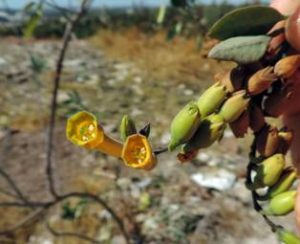
Flowers and fruit. Ian Riddell
Nicotiana is in the Solanaceae family, native to central northwest Argentina and Bolivia. Its attractiveness as an ornamental garden plant has ensured that it now grows worldwide in suitable climes and the Flora of Zimbabwe website says its habitat is along watercourses and in disturbed places. This hilltop is certainly disturbed and perhaps seeds were deposited here by people at some stage.
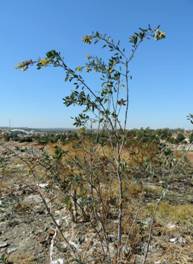
Younger plants. Photo: Ian Riddell
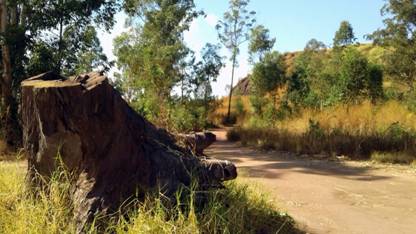
Zimphos with the purple hill in the background. Photo: Ian Riddess
According to https://www.rxlist.com/ anabasine is a stimulant at low doses and like a depressant at high doses. It is used for boils, fever, headache, pain, sore throat, wounds and as an insect repellent. In Tree Life 220 Benedicta Graves mentions that it has been known to poison cattle. However, there isn’t enough reliable information about its dosage and it is considered unsafe since anabasine can cause an unpleasant variety of symptoms from heart stoppage, brain damage, severe muscle weakness and spasms, severe vomiting, breathing problems, seizures, high blood pressure, and death! So it comes with a ‘don’t try this at home’ label, but I wonder if it is used by n’yangas in this country?
More pics on https://www.inaturalist.org/observations/55165116
(All photographs by Ian Riddell)
Ian Riddell
Trees I have planted over the Years (Part 3)
In 1992 we purchased Number 22, Bridgeways an 11 acre unit in a complex which has the Avondale River running through the middle.
The area had been part of a gum plantation. One of the first things we did was to remove the gums surrounding our property. The soil is black clay so not suited to all plants.
I was given some trees by Ron Hartley a teacher at Falcon College, so they were planted first. They included two Erythrina lysistemon, a Berchemia discolor the Bird plum, an Olea europaea and two Bolusanthus speciosus the tree Wisteria.
It is interesting to see how they fared over the last 28 years. The Olea was not happy and hardly grew so I took it out. One of the Erythrina grew very well and provided wonderful shade for our cars. Sadly, one day a gardener took into his head to prune and cut the tree back. It subsequently died. The other Erythrina is my pride and joy; it has grown into a beautiful spreading tree. We love its bright red flowers in July/August and then the shade during the hot months. The two Bolusanthus grew well but the one by my back gate died after 22 years, and 6 years later the other turned up its toes. Ron had also given me a Berchemia discolor, the Bird plum. The bark is now covered in lichen but it is very happy though as it is a male tree so we have not had any fruit.
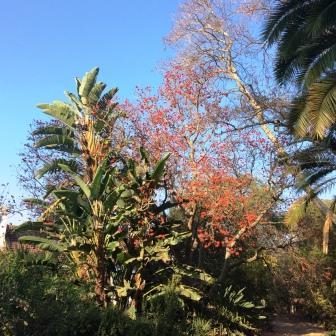
Erythrina and Strelitzia nicoli at Bridgeways. Photo: Ann Sinclair
Two Freylinia tropica are delightful small tees, the blue flowers attract many bees and butterflies and sunbirds. I planted a Karomia tettensis. Chinese hats, a small shrub or small tree, the flowers have a mauve calyx, saucer shaped and a bright blue corolla in loose sprays. There is a brick red to orange species often seen in gardens which comes from the foothills of the Himalayas in India. My Karomia came from a cutting of a tree growing in my mother’s garden on the farm.
A Schotia brachypetala stands close to the house, the roots grow straight down and do not interfere with foundations. It flowers in spring with clusters of red flowers dripping with nectar and attracting myriads of birds. It is called the weeping Boer bean. An Acacia nigrescens grows at an angle but shows off its knobby bark. These trees give a wonderful show in the valley when they flower in September with a mass of white catkins. The Faidherbia albida is one of the tallest trees in the garden but sadly has never flowered and produced its apple ring pods. Next to the Albida grows a Syzygium spp. an evergreen tree with pointed shiny leave. A Podocarpus latifolius is a slow grower but is well established.
I planted a Kei apple hedge, Dovyalis caffra, along the top of the garden. The plants all came from self seeded ones that grew round the Kei apple hedge I had on the farm. There I harvested baskets of fruit but here all the plants are male so have not produced any fruit. So sadly no Kei apple jelly.
To replace the Erythrina which died I planted a Philenoptera sutherlandii a member of the teak family, this is now a beautiful tree with deep pink to purple pea shaped flowers in terminal sprays followed by woody flat brown velvety pods. A note here to say that Mark is not sure this tree is a Philenoptera sutherlandii??
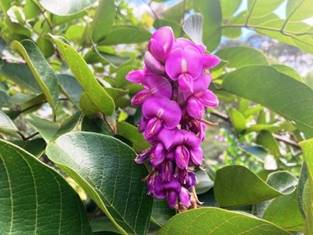
Philenoptera flowers. Photo: Ann Sinclair
Along the river I planted over time, a Dombeya rotundifolia, a Rauvolfia caffra, the quinine tree, a Craibia sp., Pseudolachnostylis maprouneifolia, the duiker berry, the leaves turn to beautiful autumn colours at the end of winter. A Celtis africana the white stink wood, in spring the leaves are a fresh bright green.
The Toad tree Tabernaemontana elegans, a small tree with a thick corky bark, deeply fissured, the flowers are white to cream and the fruit paired mericarps with the outer covering resembling the skin of a toad. The fruit splits to expose bright orange pulp containing many brown seeds. The orange pulp is enjoyed by birds.
Bridelia micrantha with dark green leaves turning to bright colors before they fall.
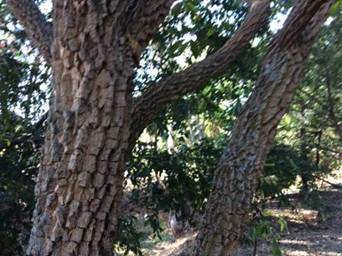
Bark of a Tabernaemontana elegans.
Photo: Ann Sinclair
Kigelia africana the sausage tree, this tree had been pot bound for a longtime before I planted it and it has taken a long time to recover but at last it does seem to be growing out.
Diospyros whyteana a small tree with shiny leaves, Diospyros mespiliformis, the ebony which grows very large in the lowveld, has been slow growing but is now a good looking tree with a distinct fissured bark.
Oncoba spinosa, a spiny shrub, the fried egg tree whose showy flowers are white with a circle of yellow stamens in the center. The fruit is hard shelled with a persistent style.
Euclea natalensis is a very slow growing small tree. The leaves are glossy and dark green above and paler underneath covered with rusty wooly hairs.
Searsia lancea, the willow Rhus, which grows along stream banks.
Fernandoa abbreviata, this tree comes from Malawi it grows tall and has very striking orange flowers with a yellow center.
Two recent additions are an Halleria, the tree fuchsia and Dais cotinifolia the Pom Pom tree with flowers like pink Pom poms.
A Podocarpus falcatus has grown well on the bank as has Dovyalis zeyheri with conspicuously shiny leaves. The shrubs Rhamnus prinoides, Bauhinia galpinii and Strelitzia regina’s were planted along the bank to hide the gum stumps.
Further along the river bank I planted a Combretum imberbe, the ironwood from the Lowveld which has grayish leaves and a distinct fissured bark. My tree suffered a setback when a falling gum branch fell on it. But it is now growing well, the trunk is branched from low down, but that does not detract from its good looks!
Combretum molle, the velvet leaved Combretum.
Combretum mossambicensis, the shaving brush Combretum and Combretum paniculatum, the Forest burning bush Combretum are rather rampant shrubs but are at the end of the line with plenty of space.
Behind the pavilion I planted a group of Duranta spp. to screen the back area, and a Dombeya rotundifolia, the wild pear. This has grown very well and has flowered well with white well branched heads. It has fared much better than the two planted closer to the river.
In the central area there are a Calodendrum capense the Cape Chestnut, donated by John Meikle. An Afzelia quanzensis, the pod mahogany, another slow grower but well worthwhile.
A Peltophorum africanum, the Rhodesian wattle which has yellow flowers in December. The indaba tree, Pappea capensis, two Khaya anthotheca and Acacia sieberiana. These have been inhibited by the gums still growing there. I keep hoping they can be taken out, but it is an expensive exercise, though they are looking old and starting to drop branches.
It has been an absorbing exercise and I am fortunate to live here where I can watch the trees as they develop.
Ann Sinclair
TREES OF THE MONTH – PURPLE, WHITE AND A DASH OF BROWN
Scarlet is the colour I usually associate with August. It’s to do with the Erythrina flowers. They haven’t disappointed me, I’ve seen many spectacular ones around the city recently. This month however, colours like purple and white and even toffee-brown have been prominent. The first ‘purple’ tree to catch my eye early in the month was the Monkey thorn, Acacia galpinii, growing in our garden. Its calyces emerge in long maroon spikes. Seen from a distance, they give the whole crown a purplish-brown tinge.
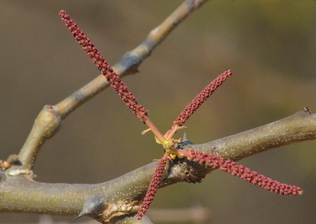
The maroon caylces of the monkey thorn . Photo: Ryan Truscott
In the two previous seasons our Monkey thorn failed to produce flowers. I put it down to drought. The emergence of the flowers this month was, to me, a hopeful sign.
It wasn’t long before I was seeing the purple crowns of Monkey thorns all over the place: on the Police Golf Course off Churchill Avenue; in a garden along Upper East Road; at the entrance to Watershed College on the Harare-Mutare road.
By the second last Sunday of August the Monkey thorns were changing from purple to yellow as their flowers emerged. Drooping toffee-brown leaves adorned the Small-fruited olax trees, Olax dissitiflora, at Paradise pools in Bindura, when my family and I visited this wild and rugged spot in early August.
I first came across the Small-fruited olax on a Tree Society visit to Paradise Pools in 2018. It was a pleasure to see this tree again in its winter colours.
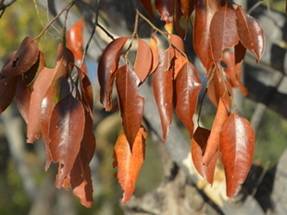
Small-fruited olax leaves in their winter-brown . Photo: Ryan Truscott
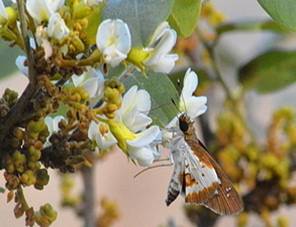
White dart foraging on the flowers of the Purplewood. Photo: Ryan Truscott
I recently learned that milky extracts from it are used to make face masks by Mozambican women. This beauty therapy, practised by generations of young women there, has been adopted by international cosmetic firms.
While at Paradise Pools I took a walk up the Pote River from the Arcadia Dam and found a small tree covered with small white flowers.
It was the Purplewood, Dalbergia nitidula. The flowers were attracting numerous insects, including one small fast-flying species of butterfly with large black eyes and white wings daubed with brown.
I couldn’t find it in the book so I consulted Ian Riddell, who identified it as the White dart, a species that occurs from here right up to South Sudan.

White dart foraging on the flowers of the Purplewood. Photo: Ryan Truscott
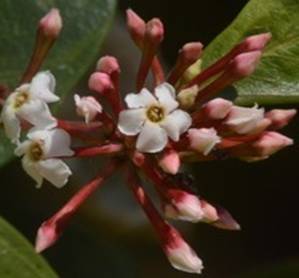
Sweet scented flowers of the Common poison-bush. Photo: Ryan Truscott
Back home, with the weather warming up and the mulberries starting to ripen, I noticed white and sweetly-scented clusters of flowers on our two Common poison-bushes, Acokanthera oppositifolia.
The toxic qualities of this species are well known. Traditionally extracts were used by hunters in some parts of Africa to tip their arrows.
If you read the Willard Price books as a child, or read them to your children, you may recall the scene in Safari Adventure in which the villainous poacher ‘Blackbeard’ tries to bump off the embattled game warden, Crosby using an extract of this plant.
The experts even warn against eating the fruit, though I’ve noticed the purple-crested turacos feasting on ours.
There’s a good reason for this. Scientists say the turacos obtain copper-based pigments from the fruit that give their primary feathers that spectacular scarlet colour you see flashing every time they fly.
Ryan Truscott
A walk in the Botanic Garden: Sunday, 15 August 2021
After such a long period of botanical inactivity caused by Covid, Tony Alegria and I decided we needed a walk in the Botanic Garden. This was to refresh our memories of the trees and also to see what was happening. The weather was dull, cloudy and cold; Spring was just getting under way, but there were still interesting plants to be seen.
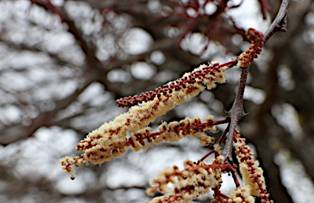
Acacia nigrescens. Photo: Mark Hyde
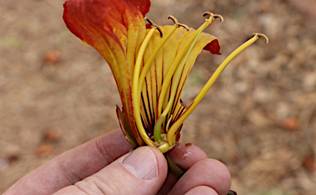
Fernandoa abbreviata corolla showing 4 stamens, 1 style and 1 staminode. Photo: Mark Hyde
Early flowering species included the white flowering spikes of Acacia nigrescens with their reddish buds appearing on the leafless branches. The Sausage trees, Kigelia africana, were in flower as also were the related Bignoniaceae,
I opened up a flower of the Fernandoa to show the inner parts. There are 4 long stamens, one slightly shorter style and also a much shorter staminode, a sterile stamen. Most Bignoniaceae have staminodes, some oddly well-developed and it is always worth opening up corollas of this family to see what they look like.

Ceiba pentandra in flower Photo: Mark Hyde
The commercial section of the Gardens has a lot of interest, some of it still to be identified. Here there is an enormous specimen of Ceiba pentandra, one of the kapok trees, just coming into flower. This is not one of the two commonly planted species in Harare streets (C. insignis and C. speciosa) and I have yet to see this species anywhere other than the Botanic Gardens. It is quite different and less ornamental in having much smaller flowers.
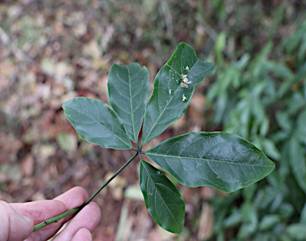
Ritchiea albersii leaf. Photo: Mark Hyde
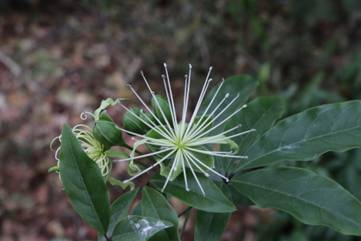
Ritchea albersii in flowers. Photo: Mark Hyde
A rarely seen genus in Zimbabwe is Ritchiea in the Capparaceae family. One of these, provisionally named as the Zimbabwean species, R. albersii, was in flower. It has typical Capparaceae flowers with a tuft of long stamens, but the leaves are somewhat unusual in being palmately divided.
Tony and I also spent some time looking at the weeds in the garden. No criticism of the Garden is intended by stating that they were there. Wherever there is disturbance weeds will appear and they will flower, even in winter. One notable species, Cotula australis, was seen; this is a slightly uncommon species. It hails from New Zealand and Australia, an unusual source for our weeds.
Perhaps the most unexpected thing was a palm near the Herbarium. It was a rattan palm, very likely a species of Calamus, covered in spines and bearing flagellae (whips) – but I will leave that one for a later article in my series on palms.
Another species flowering vigorously is Dracaena steudneri. This is a tall woody monocotyledon, very commonly grown in Harare gardens. It bears large pyramidal panicles of flowers at the branch apices. This is its typical flowering time – late winter/ early spring.
All in all it was a good walk. As the number of Covid cases is falling, it will hopefully not be too long until we can resume our regular outings.
Mark Hyde
PALMS OF HARARE – 3 SIX MORE PALMS FROM HARARE
The first two articles in this series covered a total of 13 species of palm which occur in my home suburb of Alexandra Park and in one case from Gun Hill the next-door suburb. In this article, I am casting the net a bit wider to other adjacent suburbs and discussing a further six species. All of these are somewhat less common and I usually have only a few, sometimes only one, record of each one.
However, before considering these, I have yet another comment about the two species of Archontophoenix. Another way of separating them which I did not mention was that A. alexandrae has a pale green crownshaft whereas that of A. cunninghamiana is brownish-green. I am not 100% sure this is absolutely reliable, but it worked well with two small palms adjacent to each other in Griffin Road.
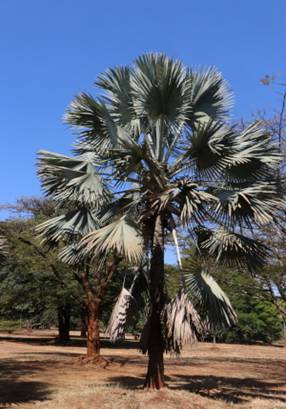
Bismarckia nobilis in the Botanic Garden. Photo: Mark Hyde
Our first palm is Bismarckia nobilis, the Bismarck palm. The specific name means ‘noble, stately’ and this is indeed a magnificent palm, built on a grand scale, with giant bluish-grey costapalmate leaves, up to 3 m across. It is a solitary, dioecious species potentially attaining 20 m, although no specimen as tall as that was seen in Harare. The generic name commemorates Otto von Bismarck, 1815-1898, the first chancellor of the German Empire. It is endemic to Madagascar but is widely cultivated in the tropics and subtropics.
I have actually only seen this palm in the Botanic Gardens, between the entrance gate and the Herbarium, but I have been told of another occurrence and two nurseries sell this species, so it is likely to be around.
On now to two native species of palm, both with costapalmate leaves. The first is Borassus aethiopum, the Borassus palm. This is another tall, solitary, dioecious species with the stem usually swollen in the upper half. The fruits are large, 12-18 cm in diameter. Although rare in Zimbabwe, it is widespread in tropical Africa and Madagascar. I have only two records of this in Harare; there are some trees in the Botanic Garden and also one specimen in the grounds of St George’s College.

Borassus aethiopum at St George’s College Photo by Mark Hyde
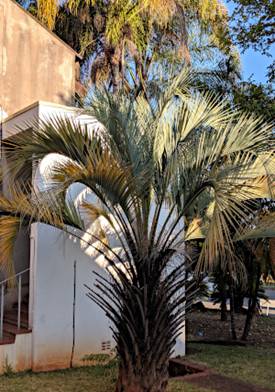
Butia odorata at St George’s College. Photo: Mark Hyde
Hyphaene petersiana, the Northern Ilala palm is fairly familiar to Tree Society members from the Zambezi Valley. This is another dioecious species with palmate leaves; the fruits are 4-6 cm in diameter and contain the hard white kernel known as “vegetable ivory”. The species occurs from the DRC south to Namibia and northern South Africa.
It does not appear to be in the horticultural trade, but it is grown by Karl van Laeren at his Borrowdale veterinary surgery.
Butia odorata (capitata) is the Jelly palm. There is some confusion about the name of this species, which is generally known as Butia capitata in the horticultural trade, but it appears to be more correctly known as B. odorata. This species is from Brazil. It can be recognised by its long arching grey-green pinnate leaves and the stem which is clothed with old leaf bases. As the common name suggests, the fruit is used to make jelly. I have only one record of this from Harare, from the grounds of St George’s College.
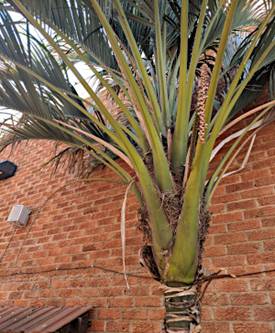
Howea forsteriana at Sam Levy’s Village. Photo: Mark Hyde
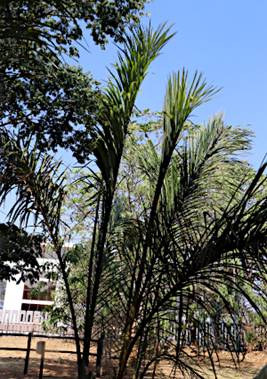
Raphia farinifera Karl van Laeren’s Borrowdale surgery Photo: Mark Hyde
The Kentia palm, Howea forsteriana, is another pinnate palm. The trunk is green with transverse narrow whitish stripes and there is no obvious crownshaft. The top of the trunk is brown and fibrous where the leaf bases join together. This is a monoecious species, bearing male and female flowers on the same tree. It is endemic to Lord Howe Island, an Australian dependency some 700 km northeast of Sydney. Both the island and the palm are named for Admiral Lord Richard Howe, 1726 – 1799. I have only seen this once – at Sam Levy’s village.
Finally, for now, we end with another native palm, Raphia farinifera, the Raffia palm. This is a monoecious tree, the base often bearing aerial roots. The leaves are pinnate and enormous and are said to be the largest leaves in the plant kingdom. The leaflets are numerous and are arranged in several planes. There used to be some very fine specimens of this in the Botanic Garden near to the Herbarium building, but they have all died. The only other record I have is from Karl van Laeren’s Borrowdale surgery.
If anyone knows of any other records of the species covered in this article, especially if they are from Harare, I would be very interested to hear of them. Any comments or corrections would also be very welcome.
Mark Hyde
CHAIRMAN – TONY ALEGRIA


